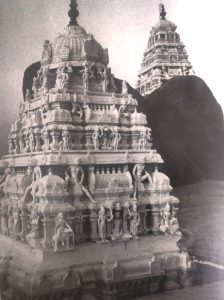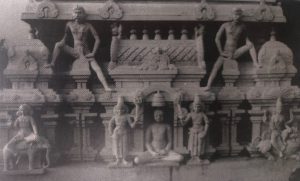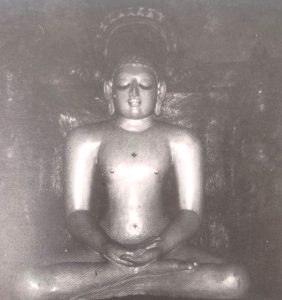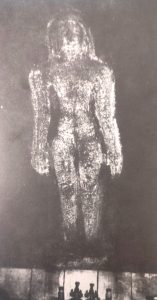Thirunarungkondai
 This large Parshvanatha Temple at Thirunarungkondai, with its two towers of uniquely Tamil architecture, was built above and around a cave-like cleft between two boulders. During the month of May each year a festival, lasting for ten days, attracts thousands of pilgrims.
This large Parshvanatha Temple at Thirunarungkondai, with its two towers of uniquely Tamil architecture, was built above and around a cave-like cleft between two boulders. During the month of May each year a festival, lasting for ten days, attracts thousands of pilgrims.
(right). Detail of the above tower showing a seated Jina with chauri- bearers (chauri = fly- 1 whisk) and two Yakshis, one riding an elephant the other a lion.
bearers (chauri = fly- 1 whisk) and two Yakshis, one riding an elephant the other a lion.
 Seated Jina, bathed in a beam of light deep down in the temple, radiates serene peace.
Seated Jina, bathed in a beam of light deep down in the temple, radiates serene peace.
The name of Thirunarungkondai applies to both the village – situated some sixty kilo- metres south of Gingee – and the nearby hill with a Jaina temple at the top.
One of the legends, collected from rural folk by Colonel Mackenzie between 1810 and 1815 and preserved in form of manuscripts, reports of a hunter and his wife who once upon a time went to Thirunarungkondai in search of edible roots.
While digging the ground, his axe struck on an image of Parshvanatha carved in high relief. There was a flash of light, emitted from the figure, that made him blind in both eyes. The hunter lamented his mistake and prayed to the Lord to restore his sight.
Parshvanatha con- ceded to his prayer and made him see again. The tribesmen, learning of the miracle, cleared the image of the accumulated earth and built a temple around it.*
(above right). This figure of a Jina in the roofed cleft, showing stylistic features of the 8th/9th century, is believed to have led to the building of the temple. To substantiate the story of the hunter, the Pilgrims’ attention is drawn to the hurt knees of the statue, the parts supposedly hit by the hunter’s axe.
*These legends were edited by T.V. Mahalingam, University of Madras, and published in 1972.
